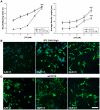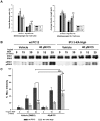IP3 3-kinase opposes NGF driven neurite outgrowth
- PMID: 22384237
- PMCID: PMC3284567
- DOI: 10.1371/journal.pone.0032386
IP3 3-kinase opposes NGF driven neurite outgrowth
Abstract
The inositol (1,4,5) trisphosphate 3-kinases comprise a family of enzymes (A, B, and C) that phosphorylate the calcium mobilising molecule inositol (1,4,5) trisphosphate (IP(3)) to generate inositol (1,3,4,5) tetrakisphosphate. This molecule can function as a second messenger, but its roles are not completely understood. The A isoform of inositol (1,4,5) trisphosphate 3-kinase localises to filamentous actin within dendritic spines in the hippocampus and is implicated in the regulation of spine morphology and long term potentiation, however the mechanisms through which it signals in neuronal cells are not completely understood. We have used NGF driven neurite outgrowth from PC12 cells as a platform to examine the impact of signaling via inositol (1,4,5) trisphosphate 3-kinase activity in a neuronal cell. We have found that the catalytic activity of the enzyme opposes neurite outgrowth, whilst pharmacological inhibition of inositol (1,4,5) trisphosphate 3-kinase leads to a significant increase in neurite outgrowth, and we show that the reduction in neurite outgrowth in response to inositol (1,4,5) trisphosphate 3-kinase activity correlates with reduced ERK activity as determined by western blotting using phosphorylation-specific antibodies. Our findings suggest a novel neuronal signaling pathway linking metabolism of IP(3) to signaling via ERK.
Conflict of interest statement
Figures




Similar articles
-
Regulation of NGF-driven neurite outgrowth by Ins(1,4,5)P3 kinase is specifically associated with the two isoenzymes Itpka and Itpkb in a model of PC12 cells.FEBS J. 2015 Jul;282(13):2553-69. doi: 10.1111/febs.13300. Epub 2015 May 7. FEBS J. 2015. PMID: 25892505
-
Potentiation of nerve growth factor-induced neurite outgrowth by the ROCK inhibitor Y-27632: a possible role of IP₃ receptors.Eur J Pharmacol. 2010 Dec 1;648(1-3):67-73. doi: 10.1016/j.ejphar.2010.09.007. Epub 2010 Sep 18. Eur J Pharmacol. 2010. PMID: 20854802
-
Nerve Growth Factor Regulates Transient Receptor Potential Vanilloid 2 via Extracellular Signal-Regulated Kinase Signaling To Enhance Neurite Outgrowth in Developing Neurons.Mol Cell Biol. 2015 Dec;35(24):4238-52. doi: 10.1128/MCB.00549-15. Epub 2015 Sep 28. Mol Cell Biol. 2015. PMID: 26416880 Free PMC article.
-
Inositol 1,4,5-trisphosphate 3-kinases: functions and regulations.Cell Res. 2005 Feb;15(2):83-91. doi: 10.1038/sj.cr.7290270. Cell Res. 2005. PMID: 15740635 Review.
-
Inositol trisphosphate 3-kinases: focus on immune and neuronal signaling.Cell Mol Life Sci. 2010 Jun;67(11):1755-78. doi: 10.1007/s00018-009-0238-5. Epub 2010 Jan 12. Cell Mol Life Sci. 2010. PMID: 20066467 Free PMC article. Review.
Cited by
-
Inhibition of Inositol Polyphosphate Kinases by Quercetin and Related Flavonoids: A Structure-Activity Analysis.J Med Chem. 2019 Feb 14;62(3):1443-1454. doi: 10.1021/acs.jmedchem.8b01593. Epub 2019 Jan 25. J Med Chem. 2019. PMID: 30624931 Free PMC article.
-
TNP [N2-(m-Trifluorobenzyl), N6-(p-nitrobenzyl)purine] ameliorates diet induced obesity and insulin resistance via inhibition of the IP6K1 pathway.Mol Metab. 2016 Aug 21;5(10):903-917. doi: 10.1016/j.molmet.2016.08.008. eCollection 2016 Oct. Mol Metab. 2016. PMID: 27689003 Free PMC article.
-
The IP6K Inhibitor LI-2242 Ameliorates Diet-Induced Obesity, Hyperglycemia, and Hepatic Steatosis in Mice by Improving Cell Metabolism and Insulin Signaling.Biomolecules. 2023 May 20;13(5):868. doi: 10.3390/biom13050868. Biomolecules. 2023. PMID: 37238737 Free PMC article.
-
Modulation of Epidermal Growth Factor Stimulated ERK Phosphorylation and Cell Motility by Inositol Trisphosphate Kinase.J Pharm Sci Pharmacol. 2014 Jun 1;1(2):160-164. doi: 10.1166/jpsp.2014.1010. J Pharm Sci Pharmacol. 2014. PMID: 26213696 Free PMC article.
-
Targeting the Inositol Pyrophosphate Biosynthetic Enzymes in Metabolic Diseases.Molecules. 2020 Mar 19;25(6):1403. doi: 10.3390/molecules25061403. Molecules. 2020. PMID: 32204420 Free PMC article. Review.
References
-
- Berridge MJ. Unlocking the secrets of cell signaling. Annu Rev Physiol. 2005;67:1–21. - PubMed
-
- Miller AT, Chamberlain PP, Cooke MP. Beyond IP3: roles for higher order inositol phosphates in immune cell signaling. Cell Cycle. 2008;7:463–467. - PubMed
-
- Pattni K, Banting G. Ins(1,4,5)P3 metabolism and the family of IP3-3Kinases. Cell Signal. 2004;16:643–654. - PubMed
Publication types
MeSH terms
Substances
Grants and funding
LinkOut - more resources
Full Text Sources
Molecular Biology Databases
Miscellaneous

